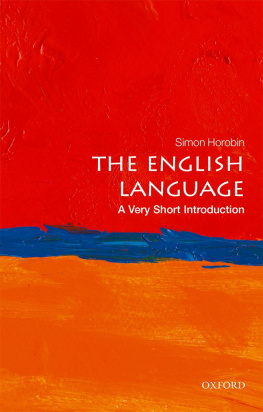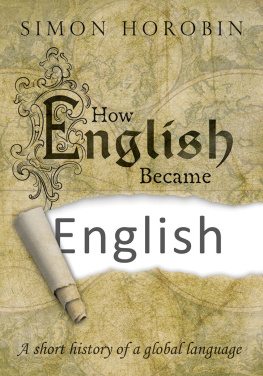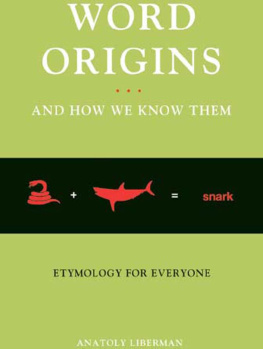Bagels, Bumf, and Buses

Great Clarendon Street, Oxford, OX2 6DP, United Kingdom
Oxford University Press is a department of the University of Oxford. It furthers the Universitys objective of excellence in research, scholarship, and education by publishing worldwide. Oxford is a registered trade mark of Oxford University Press in the UK and in certain other countries
Simon Horobin 2019
The moral rights of the author have been asserted
First Edition published in 2019
Impression: 1
All rights reserved. No part of this publication may be reproduced, stored in a retrieval system, or transmitted, in any form or by any means, without the prior permission in writing of Oxford University Press, or as expressly permitted by law, by licence or under terms agreed with the appropriate reprographics rights organization. Enquiries concerning reproduction outside the scope of the above should be sent to the Rights Department, Oxford University Press, at the address above
You must not circulate this work in any other form and you must impose this same condition on any acquirer
Published in the United States of America by Oxford University Press
198 Madison Avenue, New York, NY 10016, United States of America
British Library Cataloguing in Publication Data
Data available
Library of Congress Control Number: 2019936810
ISBN 9780198832270
ebook ISBN 9780192568281
Printed and bound in Great Britain by Clays Ltd, Elcograf S.p.A.
Links to third party websites are provided by Oxford in good faith and for information only. Oxford disclaims any responsibility for the materials contained in any third party website referenced in this work.
This book is for Lucy, Rachel, and Florence, who quickly learned to preface every question about words withthe short answer, please. This is the long answer.
Contents
There are many books that investigate the origins of English words and phrases; but these tend to focus on unusual idioms and sayingswho was the real McCoy? why was Larry so happy? how did a cat come to die of curiosity? This book differs in focusing on the words and phrases we use every dayoften without any thought as to their originsexamining where they came from, charting how their uses have evolved over the centuries, and temporarily reviving others that have fallen out of use. In short, this book is a celebration of the richness of the English language, and the fascinating stories that lie behind its word hoard.
The study of word origins is known as etymology, which is from a Greek root meaning true, reflecting the way that the ancient Greeks believed that the earliest form of a word revealed its authentic meaning. There are still those who insist that the correct meaning of English words may be determined by reference to their origins, and who claim (for instance) that decimate can only mean reduce by a tenth, since it is from Latin decimus tenth. But if we were to follow such an approach, December should be the tenth month, as it was in the Roman calendar before January and February were added. And if we did insist on only sanctioning the use of decimate in its original senseput to death one in every ten of an army of mutinous soldiershow often would we use it?
Much more interesting than trying to restrict and dictate usage is the question of how and why the meanings of these words have come to change, and what they can tell us about the people who used them. That is the subject of this book.


The alarm sounds and rouses you from a deep sleep. While we may consider the electronic buzzing of an alarm clock to be a pretty grim start to the day, the original use of alarm signalled a significantly more stressful situation. The word originates in the Italian allarme to armsa distress call issued to alert an army to an oncoming attack. The word alert has a similar military origin, deriving from the Italian phrase allerta on the watchtower. Drawing back the curtains and looking out the window reveals that a new day has dawned. The word dawn is first recorded in the sixteenth century; before that the terms used were dawning or dawing. All three derive from the verb to daw (from Old English dagian), meaning to become day. If this seems a rather unimaginative way to describe Homers rosy-fingered or bright-throned dawn, dont blame the Anglo-Saxons, since they had a selection of more poetic alternatives.

The Dawn
The Anglo-Saxons were evidently early risers, since they coined a variety of words to describe first light. They even had a word for the hour before dawnuhtanthat the rest of us would call the middle of the night. This was the hour when medieval monks celebrated the office of uht-song, now known by its Latin name Matins (still seen in the French for morning, matin). Old English also had a term for the sorrow and anxiety experienced at this time of the day, uhtceare, presumably coined by sleepy monks faced with the prospect of getting out of bed in a freezing cold dormitory (Latin dormitorium sleeping place) for uht-song. Another useful word for capturing that nebulous (Latin nebulosus cloudy) sense of foreboding that hangs over you first thing in the morning is matutolypea, a classical word literally meaning grief of the dawn.
Other Anglo-Saxon words for dawn are compoundsa common way of forming new words in Old English (and all Germanic languages). Day-rim, literally border of the day, refers to dawn as the beginning of a new day. Day-row, whose second element means ray, figures the dawn as the bringer of light; this image lies behind other terms such as rodor-lihtung illumination of the heavens and day-reddescribing the colour of the sky. The later Middle Ages added some nicely uplifting words, such as springing and uprising. The fifteenth century also saw the adoption into English of the name of Aurora, the Roman goddess of the dawn, as well as the word orient. Orient is used today to refer to the countries of the East; the word originates in Latin oriri to rise, and so referred to the East as the land of the rising sun. The occident, the equivalent term for the West, has its origins in the Latin occidere to go downland of the setting sun. The image of the rising sun as an opening eye lies behind the sixteenth-century terms peeping and peep of the day. A more dramatic image in which the sun breaks throughwhich survives in modern English daybreak and crack of dawnis found in breach of the day, sun-break, prick of the day, and creek (from a Dutch verb meaning burst through). By contrast with these poetic terms and the images they conjure up, the nineteenth-century dialect

















